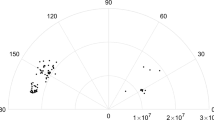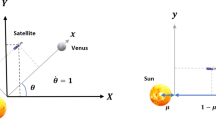Abstract
The 8th edition of the Global Trajectory Optimization Competition (GTOC8) presented a novel concept of a space-based very-long-baseline interferometry (VLBI) telescope in cislunar space for observing selected radio sources in cosmos. It requires designing a three-spacecraft triangular formation with changeable sizes and orientations such that observation can be scheduled as efficiently as possible. We first review the problem, and then describe the methods employed by representative teams participating in the competition. Subsequently, we present the design techniques employed by the team from the Chinese Academy of Sciences, which are primarily based on orbital-geometry analysis. Two efficient trajectory patterns are summarized: million-kilometer triangular formations with symmetric circular orbits, and consecutive-lunar-flyby trajectories with Moon-to-Moon transfer orbits. These two trajectory patterns enable establishing and reconfiguring the triangular formation with sufficiently different sizes so that a number of radio sources can be observed, thus maximizing the performance index. Finally, we present a solution with the best currently known score of J = 158 million km.
Similar content being viewed by others
Change history
11 February 2022
A Correction to this paper has been published: https://doi.org/10.1007/s42064-022-0136-2
References
Li, S., Huang, X. X., Yang, B. Review of optimization methodologies in global and China trajectory optimization competitions. Progress in Aerospace Sciences, 2018, 102: 60–75.
Petropoulos, A. E. Problem description for the 8th global trajectory optimisation competition. 2015.
Shen, H. X., Huang, A. Y., Zhang, Z. B., Li, H. N. GTOC8: results and methods of state key laboratory of astronautic dynamics. In: Proceedings of the 26th AAS/AIAA Space Flight Mechanics, 2016: AAS 16-384.
Izzo, D., Hennes, D., Märtens, M., Getzner, I., Nowak, K., Heffernan, A., Campagnola, S., Yam, C. H., Ozaki, N., Sugimoto, Y. GTOC8: results and methods of ESA advanced concepts team and JAXA-ISAS. In: Proceedings of the 26th AAS/AIAA Space Flight Mechanics, 2016: AAS 16-275.
Tang, G., Yang, H., Jiang, F., Baoyin, H., Li, J. GTOC8: results and methods of team3—Tsinghua University. In: Proceedings of the 26th AAS/AIAA Space Flight Mechanics, 2016: AAS 16-248.
Colasurdo, G., Casalino, L., Berga, M. D. C. GTOC8: results and methods of team 22. In: Proceeding of the 26th AAS/AIAA Space Flight Mechanics, 2016: AAS 16-283.
Yang, H. W., Tang, G., Jiang, F. H. Optimization of observing sequence based on nominal trajectories of symmetric observing configuration. Astrodynamics, 2018, 2(1): 25–37.
Gao, Y., Kluever, C. Low-thrust interplanetary orbit transfers using hybrid trajectory optimization method with multiple shooting. In: Proceedings of the AIAA/AAS Astrodynamics Specialist Conference and Exhibit, 2004: 2004–5088.
Zhu, Z. F., Gan, Q. B., Yang, X., Gao, Y. Solving fuel-optimal low-thrust orbital transfers with Bang-Bang control using a novel continuation technique. Acta Astronautica, 2017, 137: 98–113.
Uphoff, C. W. The art and science of lunar gravity assist. In: Proceedings of the AAS/GSFC International Symposium on Orbital Mechanics and Mission Design, 1989: AAS-89-170.
Uphoff, C. W., Crouch, M. A. Lunar cycler orbits with alternating semi-monthly transfer windows. Journal of the Astronautical Sciences, 1993, 41(2): 189–205.
Hénon, M. Numerical exploration of the restricted problem. V: Hill’s case: periodic orbits and their stability. Astronomy and Astrophysics, 1969, 1: 223–238.
Howell, K. C. Consecutive collision orbits in the limiting case μ = 0 of the elliptic restricted problem. Celestial Mechanics, 1987, 40(3–4): 393–407.
Russell, R. P., Ocampo, C. A. Geometric analysis of free-return trajectories following a gravity-assisted flyby. Journal of Spacecraft and Rockets, 2005, 42(1): 138–152.
Strange, N. J. Analytical methods for gravity-assist tour design. Ph.D. Dissertation. Aeronautics and Astronautics Department, American Purdue University, 2016.
Acknowledgements
We would like to express our gratitude to Anastassios Petropoulos for releasing this interesting problem, which provided us with the opportunity to think about the formation flying design for space-based VLBI observations, and to Dr. Hongxin Shen from the State Key Lab of Astronautic Dynamics for his kindly help to verify the revised design result. Moreover, our design efforts are based on research supported by the National Natural Science Foundation of China (No. 11372311) and the Key Research Program of the Chinese Academy of Sciences (No. ZDRW-KT-2019-1).
Author information
Authors and Affiliations
Corresponding author
Additional information
Shengmao He received his doctoral degree from the University of the Chinese Academy of Sciences in 2019. Since June 2019, he has been a post-doctoral research fellow at the Technology and Engineering Center for Space Utilization, Chinese Academy of Sciences. His research interests include global trajectory design and optimization, and low-thrust trajectory design.
Zhengfan Zhu received his doctoral degree from the University of Chinese Academy of Sciences in 2018. Since February 2018, he has been an engineer with DFH Satellite Co., Ltd. His research interests include spacecraft dynamics and control, low-thrust trajectory optimization, and space mission design.
Rights and permissions
About this article
Cite this article
He, S., Zhu, Z. Efficient design techniques for cislunar-space VLBI spacecraft formation in GTOC8. Astrodyn 5, 61–76 (2021). https://doi.org/10.1007/s42064-020-0096-3
Received:
Accepted:
Published:
Issue Date:
DOI: https://doi.org/10.1007/s42064-020-0096-3




